Apple Officially Enters AR/XR With Vision Pro Headset
- Oops!Something went wrong.Please try again later.

Apple is now officially a mixed-reality company.
At its Worldwide Developers Conference on Monday, chief executive officer Tim Cook and executives introduced the Vision Pro, the long-rumored and highly anticipated AR/XR headset and a raft of features for work, entertainment, communication and more rolled up into a new platform and app store.
More from WWD
The device — Apple’s first major new product release since the Apple Watch in 2015 — follows many of the leaks and rumors, with the chatter hitting a fever pitch leading up to the conference keynote. As expected, the product invokes a bit of ski-mask energy. The rounded headset cradles the upper face, as if trying to keep a flurry away from the eyes while on the slopes.
But instead of plastic, the unit is built with a streamlined curved glass and component structure designed to maximize comfort. Apple made a number of important design decisions, including kicking the battery out of the physical headset into a separate attachment. The result significantly reduces weight and bulk, according to the company. It also integrated Zeiss custom optical inserts, so the unit can work with different vision requirements.
While users can interact using an Apple Magic Keyboard and Trackpad for, say, productivity, Apple poured a lot of effort into developing myriad gestures, like mid-air finger taps and hand motions.
“With Vision Pro, we set the ambitious goal to design an incredibly intuitive input model for spatial computing, where that can be used without controllers or additional hardware,” explained Alan Dye, Apple’s vice president of human interface design. In a video demo, a user wearing the headset merely glanced at a Mac and the system projected a super-sized 4K virtual display that mirrored the physical screen. It works by tracking where the user looks and registering that as inputs, thanks to an Apple-developed sensor array and system called Optical ID.

“Vision Pro relies solely on your eyes, hands and voice. It’s just you and your content,” he added. “It’s remarkable, and it feels like magic.”
According to the announcement, the unit features an ultra-high-resolution display system packed with 23 million pixels across two displays, and customized dual-chip Apple processors “to ensure every experience feels like it’s taking place in front of the user’s eyes in real time.”
Vision Pro represents several firsts for Apple. Most obviously, the device is Apple’s first AR headset. But people can also snap 3D images of the real world directly from the headset, making it the company’s first 3D camera as well. Executives noted that Vision Pro, perhaps in its entirety, marks its very first spatial computer, one that’s capable of working alongside the iPhone, iPad and Mac and turning experiences like gaming, streaming shows or video calling into a much more immersive affair.
When it comes to immersiveness, the bigger the visual, the better. With AR, iPhone panorama photos can wrap around users, making them feel like they’re right back at the mountain, beach or party. For FaceTime, and soon Zoom and Webex video chat, friends or colleagues can show up practically life-size in the virtual view. People can watch a movie on a huge virtual movie screen alone or with others using SharePlay. Apple’s investments in spatial audio should shine here, with a newfound directionality that feels more realistic.
Technologists have been abuzz for years about the advent of ambient or spatial computing, which is supposed to replace physical displays, allowing them to interact with technology in more human-oriented ways. They can look up, talk, gesture or even view data and images without burying themselves into a device. But in that case, producing a headset as comfortable and ubiquitous as eyeglasses will be essential. As it is, it’s hard to imagine anyone wearing the Vision Pro for hours on end.

Even so, at least ski goggles may be a step in the right direction, particularly if they’re lightweight. Cook and company’s excitement seems palpable. With partners Disney and Unity, Apple wants to ensure plenty of content, special features and immersive twists on existing shows and more from games and movies to sports.
In other words, this isn’t merely the birth of a new gadget. It’s the start of a whole new platform called Vision OS, along with a new app store. That may present an opportunity for some branding or commerce experiences.
It’s clear that this is a major milestone for the company; the CEO signaled as much by waiting until the end, after the list of refinements to Mac OS, iOS, iPad OS and Watch OS, to invoke the “one more thing” line made famous by his predecessor, the late Steve Jobs, to introduce the device. He rarely, if ever, does that.
“It’s already been a big day. But we do have one more thing,” Cook said. “This is a day that’s been years in the making. One that I’ve really been looking forward to. I believe that augmented reality is a profound technology. Blending digital content with the real world can unlock experiences, like nothing we’ve ever seen.”
There is one more thing consumers will have to note, however, and that’s the price. When it launches early next year in the U.S., it will cost an eye-watering $3,499.
Best of WWD

